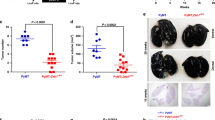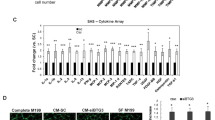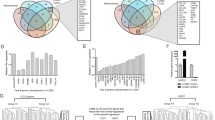Abstract
Vascular endothelial growth factor-A (VEGF), a potent angiogenic factor, is also implicated in self-renewal in several normal tissue types. VEGF has been shown to drive malignant stem cells but mechanisms thereof and tumor types affected are not fully characterized. Here, we show VEGF promotes breast and lung cancer stem cell (CSC) self-renewal via VEGF receptor-2 (VEGFR-2)/STAT3-mediated upregulation of Myc and Sox2. VEGF increased tumor spheres and aldehyde dehydrogenase activity, both proxies for stem cell function in vitro, in triple-negative breast cancer (TNBC) lines and dissociated primary cancers, and in lung cancer lines. VEGF exposure before injection increased breast cancer-initiating cell abundance in vivo yielding increased orthotopic tumors, and increased metastasis from orthotopic primaries and following tail vein injection without further VEGF treatment. VEGF rapidly stimulated VEGFR-2/JAK2/STAT3 binding and activated STAT3 to bind MYC and SOX2 promoters and induce their expression. VEGFR-2 knockdown or inhibition abrogated VEGF-mediated STAT3 activation, MYC and SOX2 induction and sphere formation. Notably, knockdown of either STAT3, MYC or SOX2 impaired VEGF-upregulation of pSTAT3, MYC and SOX2 expression and sphere formation. Each transcription factor, once upregulated, appears to promote sustained activation of the others, creating a feed-forward loop to drive self-renewal. Thus, in addition to angiogenic effects, VEGF promotes tumor-initiating cell self-renewal through VEGFR-2/STAT3 signaling. Analysis of primary breast and lung cancers (>1300 each) showed high VEGF expression, was prognostic of poor outcome and strongly associated with STAT3 and MYC expression, supporting the link between VEGF and CSC self-renewal. High-VEGF tumors may be most likely to escape anti-angiogenics by upregulating VEGF, driving CSC self-renewal to re-populate post-treatment. Our work highlights the need to better define VEGF-driven cancer subsets and supports further investigation of combined therapeutic blockade of VEGF or VEGFR-2 and JAK2/STAT3.
This is a preview of subscription content, access via your institution
Access options
Subscribe to this journal
Receive 50 print issues and online access
$259.00 per year
only $5.18 per issue
Buy this article
- Purchase on Springer Link
- Instant access to full article PDF
Prices may be subject to local taxes which are calculated during checkout







Similar content being viewed by others
References
Dalerba P, Cho RW, Clarke MF Cancer stem cells: models and concepts. Annu Rev Med 2007; 58: 267–284.
Takebe N, Harris PJ, Warren RQ, Ivy SP Targeting cancer stem cells by inhibiting Wnt, Notch, and Hedgehog pathways. Nat Rev Clin Oncol 2011; 8: 97–106.
Al Hajj M, Wicha MS, Benito-Hernandez A, Morrison SJ, Clarke MF Prospective identification of tumorigenic breast cancer cells. Proc Natl Acad Sci USA 2003; 100: 3983–3988.
Ginestier C, Hur MH, Charafe-Jauffret E, Monville F, Dutcher J, Brown M et al. ALDH1 is a marker of normal and malignant human mammary stem cells and a predictor of poor clinical outcome. Cell Stem Cell 2007; 1: 555–567.
Li L, Neaves WB Normal stem cells and cancer stem cells: the niche matters. Cancer Res 2006; 66: 4553–4557.
Malanchi I, Santamaria-Martinez A, Susanto E, Peng H, Lehr HA, Delaloye JF et al. Interactions between cancer stem cells and their niche govern metastatic colonization. Nature 2012; 481: 85–89.
Chung AS, Lee J, Ferrara N Targeting the tumour vasculature: insights from physiological angiogenesis. Nat Rev Cancer 2010; 10: 505–514.
Olsson AK, Dimberg A, Kreuger J, Claesson-Welsh L VEGF receptor signalling? in control of vascular function. Nat Rev Mol Cell Biol 2006; 7: 359–371.
Guo S, Colbert LS, Fuller M, Zhang Y, Gonzalez-Perez RR Vascular endothelial growth factor receptor-2 in breast cancer. Biochim Biophys Acta 2010; 1806: 108–121.
Tanno S, Ohsaki Y, Nakanishi K, Toyoshima E, Kikuchi K . Human small cell lung cancer cells express functional VEGF receptors, VEGFR-2 and VEGFR-3. Lung Cancer 2004; 46: 11–19.
Lee TH, Avraham HK, Jiang S, Avraham S Vascular endothelial growth factor modulates the transendothelial migration of MDA-MB-231 breast cancer cells through regulation of brain microvascular endothelial cell permeability. J Biol Chem 2003; 278: 5277–5284.
Yang F, Tang X, Riquelme E, Behrens C, Nilsson MB, Giri U et al. Increased VEGFR-2 gene copy is associated with chemoresistance and shorter survival in patients with non small-cell lung carcinoma who receive adjuvant chemotherapy. Cancer Res 2011; 71: 5512–5521.
Lichtenberger BM, Tan PK, Niederleithner H, Ferrara N, Petzelbauer P, Sibilia M Autocrine VEGF signaling synergizes with EGFR in tumor cells to promote epithelial cancer development. Cell 2010; 140: 268–279.
Kane NM, Xiao Q, Baker AH, Luo Z, Xu Q, Emanueli C Pluripotent stem cell differentiation into vascular cells: a novel technology with promises for vascular re(generation). Pharmacol Ther 2011; 129: 29–49.
Gerber HP, Malik AK, Solar GP, Sherman D, Liang XH, Meng G et al. VEGF regulates haematopoietic stem cell survival by an internal autocrine loop mechanism. Nature 2002; 417: 954–958.
Nourse MB, Halpin DE, Scatena M, Mortisen DJ, Tulloch NL, Hauch KD et al. VEGF induces differentiation of functional endothelium from human embryonic stem cells: implications for tissue engineering. Arterioscler Thromb Vasc Biol 2010; 30: 80–89.
Calvo CF, Fontaine RH, Soueid J, Tammela T, Makinen T, Alfaro-Cervello C et al. Vascular endothelial growth factor receptor 3 directly regulates murine neurogenesis. Genes Dev 2011; 25: 831–844.
Verseijden F, Jahr H, Posthumus-van Sluijs SJ, Ten Hagen TL, Hovius SE, Seynhaeve AL et al. Angiogenic capacity of human adipose-derived stromal cells during adipogenic differentiation: an in vitro study. Tissue Eng Part A 2009; 15: 445–452.
Hamerlik P, Lathia JD, Rasmussen R, Wu Q, Bartkova J, Lee M et al. Autocrine VEGF-VEGFR2-Neuropilin-1 signaling promotes glioma stem-like cell viability and tumor growth. J Exp Med 2012; 209: 507–520.
Beck B, Driessens G, Goossens S, Youssef KK, Kuchnio A, Caauwe A et al. A vascular niche and a VEGF-Nrp1 loop regulate the initiation and stemness of skin tumours. Nature 2011; 478: 399–403.
Pastrana E, Silva-Vargas V, Doetsch F Eyes wide open: a critical review of sphere-formation as an assay for stem cells. Cell Stem Cell 2011; 8: 486–498.
Ince TA, Richardson AL, Bell GW, Saitoh M, Godar S, Karnoub AE et al. Transformation of different human breast epithelial cell types leads to distinct tumor phenotypes. Cancer Cell 2007; 12: 160–170.
Drews-Elger K, Brinkman JA, Miller P, Shah SH, Harrell JC, da Silva TG et al. Primary breast tumor-derived cellular models: characterization of tumorigenic, metastatic, and cancer-associated fibroblasts in dissociated tumor (DT) cultures. Breast Cancer Res Treat 2014; 144: 503–517.
Bayliss J, Hilger A, Vishnu P, Diehl K, El-Ashry D Reversal of the estrogen receptor negative phenotype in breast cancer and restoration of antiestrogen response. Clin Cancer Res 2007; 13: 7029–7036.
Mishra DK, Creighton CJ, Zhang Y, Gibbons DL, Kurie JM, Kim MP Gene expression profile of A549 cells from tissue of 4D model predicts poor prognosis in lung cancer patients. Int J Cancer 2013; 134: 789–798.
Liu S, Dontu G, Wicha MS Mammary stem cells, self-renewal pathways, and carcinogenesis. Breast Cancer Res 2005; 7: 86–95.
Jeter CR, Liu B, Liu X, Chen X, Liu C, Calhoun-Davis T et al. NANOG promotes cancer stem cell characteristics and prostate cancer resistance to androgen deprivation. Oncogene 2011; 30: 3833–3845.
Yu F, Li J, Chen H, Fu J, Ray S, Huang S et al. Kruppel-like factor 4 (KLF4) is required for maintenance of breast cancer stem cells and for cell migration and invasion. Oncogene 2011; 30: 2161–2172.
Bass AJ, Watanabe H, Mermel CH, Yu S, Perner S, Verhaak RG et al. SOX2 is an amplified lineage-survival oncogene in lung and esophageal squamous cell carcinomas. Nat Genet 2009; 41: 1238–1242.
Annovazzi L, Mellai M, Caldera V, Valente G, Schiffer D . SOX2 expression and amplification in gliomas and glioma cell lines. Cancer Genomics Proteomics 2011; 8: 139–147.
Xiang R, Liao D, Cheng T, Zhou H, Shi Q, Chuang TS et al. Downregulation of transcription factor SOX2 in cancer stem cells suppresses growth and metastasis of lung cancer. Br J Cancer 2011; 104: 1410–1417.
Leis O, Eguiara A, Lopez-Arribillaga E, Alberdi MJ, Hernandez-Garcia S, Elorriaga K et al. Sox2 expression in breast tumours and activation in breast cancer stem cells. Oncogene 2011; 31: 1354–1365.
Bromberg J, Wang TC Inflammation and cancer: IL-6 and STAT3 complete the link. Cancer Cell 2009; 15: 79–80.
Marotta LL, Almendro V, Marusyk A, Shipitsin M, Schemme J, Walker SR et al. The JAK2/STAT3 signaling pathway is required for growth of CD44+CD24− stem cell-like breast cancer cells in human tumors. J Clin Invest 2011; 121: 2723–2735.
Kidder BL, Yang J, Palmer S . Stat3 and c-Myc genome-wide promoter occupancy in embryonic stem cells. PLoS ONE 2008; 3: e3932.
Meyer N, Penn LZ Reflecting on 25 years with MYC. Nat Rev Cancer 2008; 8: 976–990.
Ryden L, Stendahl M, Jonsson H, Emdin S, Bengtsson NO, Landberg G . Tumor-specific VEGF-A and VEGFR2 in postmenopausal breast cancer patients with long-term follow-up. Implication of a link between VEGF pathway and tamoxifen response. Breast Cancer Res Treat 2005; 89: 135–143.
Brekken RA, Overholser JP, Stastny VA, Waltenberger J, Minna JD, Thorpe PE Selective Inhibition of vascular endothelial growth factor (VEGF) receptor 2 (KDR/Flk-1) activity by a monoclonal Anti-VEGF antibody blocks tumor growth in mice. Cancer Res 2000; 60: 5117–5124.
Kessler JD, Kahle KT, Sun T, Meerbrey KL, Schlabach MR, Schmitt EM et al. A SUMOylation-dependent transcriptional subprogram is required for Myc-driven tumorigenesis. Science 2012; 335: 348–353.
Cao Y Angiogenesis modulates adipogenesis and obesity. J Clin Invest 2007; 117: 2362–2368.
Tang JM, Wang JN, Zhang L, Zheng F, Yang JY, Kong X et al. VEGF/SDF-1 promotes cardiac stem cell mobilization and myocardial repair in the infarcted heart. Cardiovasc Res 2011; 91: 402–411.
Brusselmans K, Bono F, Collen D, Herbert JM, Carmeliet P, Dewerchin M A novel role for vascular endothelial growth factor as an autocrine survival factor for embryonic stem cells during hypoxia. J Biol Chem 2005; 280: 3493–3499.
Deasy BM, Feduska JM, Payne TR, Li Y, Ambrosio F, Huard J Effect of VEGF on the regenerative capacity of muscle stem cells in dystrophic skeletal muscle. Mol Ther 2009; 17: 1788–1798.
Goel HL, Mercurio AM VEGF targets the tumour cell. Nat Rev Cancer 2013; 13: 871–882.
Bao S, Wu Q, Sathornsumetee S, Hao Y, Li Z, Hjelmeland AB et al. Stem cell-like glioma cells promote tumor angiogenesis through vascular endothelial growth factor. Cancer Res 2006; 66: 7843–7848.
Folkins C, Shaked Y, Man S, Tang T, Lee CR, Zhu Z et al. Glioma tumor stem-like cells promote tumor angiogenesis and vasculogenesis via vascular endothelial growth factor and stromal-derived factor 1. Cancer Res 2009; 69: 7243–7251.
Gilbertson RJ, Rich JN Making a tumour′s bed: glioblastoma stem cells and the vascular niche. Nat Rev Cancer 2007; 7: 733–736.
Calabrese C, Poppleton H, Kocak M, Hogg TL, Fuller C, Hamner B et al. A perivascular niche for brain tumor stem cells. Cancer Cell 2007; 11: 69–82.
Li Z, Bao S, Wu Q, Wang H, Eyler C, Sathornsumetee S et al. Hypoxia-inducible factors regulate tumorigenic capacity of glioma stem cells. Cancer Cell 2009; 15: 501–513.
Goel HL, Pursell B, Chang C, Shaw LM, Mao J, Simin K et al. GLI1 regulates a novel neuropilin-2/alpha6beta1 integrin based autocrine pathway that contributes to breast cancer initiation. EMBO Mol Med 2013; 5: 488–508.
Neufeld G, Cohen T, Gengrinovitch S, Poltorak Z Vascular endothelial growth factor (VEGF) and its receptors. FASEB J 1999; 13: 9–22.
Shibuya M Vascular endothelial growth factor-dependent and -independent regulation of angiogenesis. BMB Rep 2008; 41: 278–286.
Chatterjee S, Heukamp LC, Siobal M, Schöttle J, Wieczorek C, Peifer M et al. Tumor VEGF:VEGFR2 autocrine feed-forward loop triggers angiogenesis in lung cancer. J Clin Invest 2013; 123: 1732–1740.
Foshay KM, Gallicano GI Regulation of Sox2 by STAT3 initiates commitment to the neural precursor cell fate. Stem Cells Dev 2008; 17: 269–278.
Nair R, Roden DL, Teo WS, McFarland A, Junankar S, Ye S et al. c-Myc and Her2 cooperate to drive a stem-like phenotype with poor prognosis in breast cancer. Oncogene 2014; 33: 3992–4002.
Heath VL, Bicknell R Anticancer strategies involving the vasculature. Nat Rev Clin Oncol 2009; 6: 395–404.
Boere IA, Hamberg P, Sleijfer S It takes two to tango: combinations of conventional cytotoxics with compounds targeting the vascular endothelial growth factor receptor pathway in patients with solid malignancies. Cancer Sci 2010; 101: 7–15.
Ivy SP, Wick JY, Kaufman BM An overview of small-molecule inhibitors of VEGFR signaling. Nat Rev Clin Oncol 2009; 6: 569–579.
Miller KD E2100: a phase III trial of paclitaxel versus paclitaxel/bevacizumab for metastatic breast cancer. Clin Breast Cancer 2003; 3: 421–422.
Montero AJ, Escobar M, Lopes G, Gluck S, Vogel C Bevacizumab in the treatment of metastatic breast cancer: friend or foe? Curr Oncol Rep 2012; 14: 1–11.
Montero AJ, Vogel C Fighting fire with fire: rekindling the bevacizumab debate. New Engl J Med 2012; 366: 374–375.
Ebos JM, Lee CR, Cruz-Munoz W, Bjarnason GA, Christensen JG, Kerbel RS Accelerated metastasis after short-term treatment with a potent inhibitor of tumor angiogenesis. Cancer Cell 2009; 15: 232–239.
Páez-Ribes M, Allen E, Hudock J, Takeda T, Okuyama H, Vinals F et al. Antiangiogenic therapy elicits malignant progression of tumors to increased local invasion and distant metastasis. Cancer Cell 2009; 15: 220–231.
Sakariassen PO, Prestegarden L, Wang J, Skaftnesmo KO, Mahesparan R, Molthoff C et al. Angiogenesis-independent tumor growth mediated by stem-like cancer cells. Proc Natl Acad Sci USA 2006; 103: 16466–16471.
Conley SJ, Gheordunescu E, Kakarala P, Newman B, Korkaya H, Heath AN et al. Antiangiogenic agents increase breast cancer stem cells via the generation of tumor hypoxia. Proc Natl Acad Sci USA 2012; 109: 2784–2789.
Creighton CJ, Li X, Landis M, Dixon JM, Neumeister VM, Sjolund A et al. Residual breast cancers after conventional therapy display mesenchymal as well as tumor-initiating features. Proc Natl Acad Sci USA 2009; 106: 13820–13825.
Feng XH The changing faces of cancer cells. Nat Rev Mol Cell Biol 2010; 11: 466.
Han H, Silverman JF, Santucci TS, Macherey RS, d’Amato TA, Tung MY et al. Vascular endothelial growth factor expression in stage I non-small cell lung cancer correlates with neoangiogenesis and a poor prognosis. Ann Surg Oncol 2001; 8: 72–79.
Cao X, Geradts J, Dewhirst MW, Lo HW Upregulation of VEGF-A and CD24 gene expression by the tGLI1 transcription factor contributes to the aggressive behavior of breast cancer cells. Oncogene 2012; 31: 104–115.
Ellis LM, Hicklin DJ VEGF-targeted therapy: mechanisms of anti-tumour activity. Nat Rev Cancer 2008; 8: 579–591.
Minn AJ, Gupta GP, Siegel PM, Bos PD, Shu W, Giri DD et al. Genes that mediate breast cancer metastasis to lung. Nature 2005; 436: 518–524.
Dontu G, Abdallah WM, Foley JM, Jackson KW, Clarke MF, Kawamura MJ et al. In vitro propagation and transcriptional profiling of human mammary stem/progenitor cells. Genes Dev 2003; 17: 1253–1270.
Assou S, Le CT, Tondeur S, Strom S, Gabelle A, Marty S et al. A meta-analysis of human embryonic stem cells transcriptome integrated into a web-based expression atlas. Stem Cells 2007; 25: 961–973.
Acknowledgements
This work was supported by the Breast Cancer Research Foundation (JMS) and P30 CA125123 (CJC). We thank Fengju Chen for technical assistance. We also thank Dr Brekken (UT southwestern Medical Center) for providing VEGFR-2 blocking antibody 2C3.
Author information
Authors and Affiliations
Corresponding author
Ethics declarations
Competing interests
The authors declare no conflict of interest.
Additional information
Supplementary Information accompanies this paper on the Oncogene website
Supplementary information
Rights and permissions
About this article
Cite this article
Zhao, D., Pan, C., Sun, J. et al. VEGF drives cancer-initiating stem cells through VEGFR-2/Stat3 signaling to upregulate Myc and Sox2. Oncogene 34, 3107–3119 (2015). https://doi.org/10.1038/onc.2014.257
Received:
Revised:
Accepted:
Published:
Issue Date:
DOI: https://doi.org/10.1038/onc.2014.257
This article is cited by
-
Toward Characterizing Lymphatic Vasculature in the Mammary Gland During Normal Development and Tumor-Associated Remodeling
Journal of Mammary Gland Biology and Neoplasia (2024)
-
c-MYC mediates the crosstalk between breast cancer cells and tumor microenvironment
Cell Communication and Signaling (2023)
-
Membrane progesterone receptor α (mPRα) enhances hypoxia-induced vascular endothelial growth factor secretion and angiogenesis in lung adenocarcinoma through STAT3 signaling
Journal of Translational Medicine (2022)
-
Therapy-induced senescence promotes breast cancer cells plasticity by inducing Lipocalin-2 expression
Oncogene (2022)
-
Neuropilin-2 promotes lineage plasticity and progression to neuroendocrine prostate cancer
Oncogene (2022)



